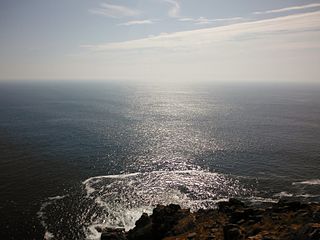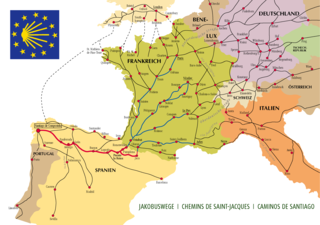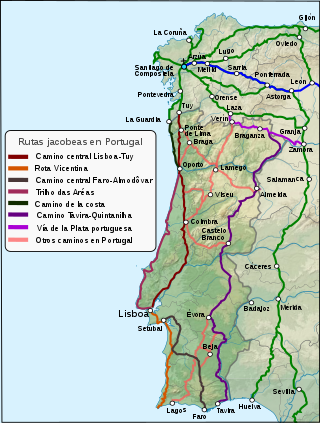
Santiago de Compostela or Compostela is the capital of the autonomous community of Galicia, in northwestern Spain. The city has its origin in the shrine of Saint James the Great, now the Cathedral of Santiago de Compostela, as the destination of the Way of St. James, a leading Catholic pilgrimage route since the 9th century. In 1985, the city's Old Town was designated a UNESCO World Heritage Site.

Cape Finisterre is a rock-bound peninsula on the west coast of Galicia, Spain.

The Camino de Santiago, or in English the Way of St. James, is a network of pilgrims' ways or pilgrimages leading to the shrine of the apostle James in the cathedral of Santiago de Compostela in Galicia in northwestern Spain, where tradition holds that the remains of the apostle are buried.

The Santiago de Compostela Arch cathedral Basilica is part of the Metropolitan Archdiocese of Santiago de Compostela and is an integral component of the Santiago de Compostela World Heritage Site in Galicia, Spain. The cathedral is the reputed burial place of Saint James the Great, one of the apostles of Jesus Christ. It is also among the remaining churches in the world built over the tomb of an apostle, the other ones being St Peter's Basilica in Vatican City, St Thomas Cathedral Basilica in Chennai, India and Basilica of St. John in Izmir, Turkey.

Puente la Reina is a town and municipality located in the autonomous community of Navarre, in northern Spain.

The Camino de Santiago, also known as the Way of St. James, extends from different countries of Europe, and even North Africa, on its way to Santiago de Compostela and Finisterre. The local authorities try to restore many of the ancient routes, even those used in a limited period, in the interest of tourism.

Santiago–Rosalía de Castro Airport, previously named Lavacolla Airport and also known as Santiago de Compostela Airport, is an international airport serving the autonomous community and historic nationality of Galicia in Spain. It is the 2nd busiest airport in northern Spain after Bilbao Airport. It has been named after the Galician romanticist writer and poet Rosalía de Castro, since 12 March 2020.
The Confraternity of Saint James is a pilgrims' association, educational charity and book publisher for the ancient and modern-day pilgrim route Camino de Santiago or "way of Saint James" to the city of Santiago de Compostela in Galicia in northern Spain.

Tosantos is a municipality and town located in the province of Burgos, Castile and León, Spain. According to the 2004 census (INE), the municipality has a population of 60 inhabitants. Tosantos is located on the Camino de Santiago de Compostela, a 1200-year-old pilgrimage route that runs through France and Northern Spain to the Spanish city of Santiago. The hamlet has a pilgrim hostel which is open from April through October and hosts up to 50 pilgrims a night.

The Hostal dos Reis Católicos, also called the Hostal de Los Reyes Católicos or Parador de Santiago de Compostela, is a five-star Parador hotel, located in the Praza do Obradoiro of Santiago de Compostela, Spain. It is widely considered one of the oldest continuously operating hotels in the world, and has also been called the "most beautiful hotel in Europe".

Dominic de la Calzada was a saint from a cottage in Burgos very close to La Rioja.

Auditorio Monte do Gozo is an outdoor concert venue in Santiago de Compostela, Galicia, Spain. It is an amphitheatre-like setting, with a stage, an open area, and then rows of concrete bench seating arranged in a semicircle. It has a capacity that has been stated as anywhere from 30,000 to 40,000 people, with one account stating an official capacity at 37,800.

Moratinos, is a town in Palencia, Spain which is located about 67 kilometers northwest of the capital of the province. It is best known to outsiders for "el castillo de Moratinos", an ages-old hill in the town center studded with family owned wine-storage caves.

The Plaza del Obradoiro is main square of the Santiago de Compostela old town, although not placed at the real centre. It lies to the West of the main façade of the Santiago de Compostela cathedral, and thus the Pórtico da Gloria must be crossed to get into the building from the square. It is surrounded by four important buildings, said to represent the four powers of the city: the aforementioned Santiago de Compostela cathedral to the East, Hostal dos Reis Católicos to the North, Pazo de Raxoi to the West and the Colexio de San Xerome to the South. Once being crossed by cars, now is mainly pedestrian as the rest of the old town, with only traffic for taxis and (un)loading delivery lorries.

The Portuguese Way is the name of the Camino de Santiago pilgrimage routes starting in Portugal. It begins at Porto or Lisbon. From Porto, along the Douro River, pilgrims travel north crossing the five main rivers—the Ave, Cávado, Neiva, Lima and Minho—before entering Spain and passing through Pontevedra on the way to Santiago de Compostela.
The English Way is one of the paths of the Camino de Santiago. It begins in the Galician port cities of Ferrol (118 km) or A Coruña (75 km) and continues south to Santiago de Compostela.
The Primitive Way is one of the paths of the Camino de Santiago. It begins in the old Asturian capital of Oviedo and runs west to Lugo and then south to Santiago de Compostela joining the more popular French Way in Melide for the last two hiking days. According to the Confraternity of St James, the Camino Primitivo is approximately 320 km in length.
World Youth Day 1989 was an event organized by the Catholic Church and took place on 15–20 August 1989 in Santiago de Compostela, Spain. It was the first European edition of this bi-tri-ennal event, excluding the two "zero editions" held in Rome in 1984 and 1985, and the first time the meeting did not take place on Palm Sunday, but in the middle of summer.
O Milladoiro is a Spanish town located in the parish of Viduido, in the municipality of Ames, in the province of A Coruña, Galicia. It currently has 13,352 inhabitants.

The Routes of Santiago de Compostela: Camino Francés and Routes of Northern Spain is a UNESCO World Heritage Site located in Spain. It was designated in 1993, and later expanded and renamed in 2015. The complete site includes a network of five traditional pilgrimage routes of the Way of Saint James as it passes through Northern Spain: the popular French Way, the Primitive Way, the Northern or Coastal Way, the Interior Way and the Liébana Route; as well as 16 of the most "culturally significant" individual structures, including religious and civil buildings.















